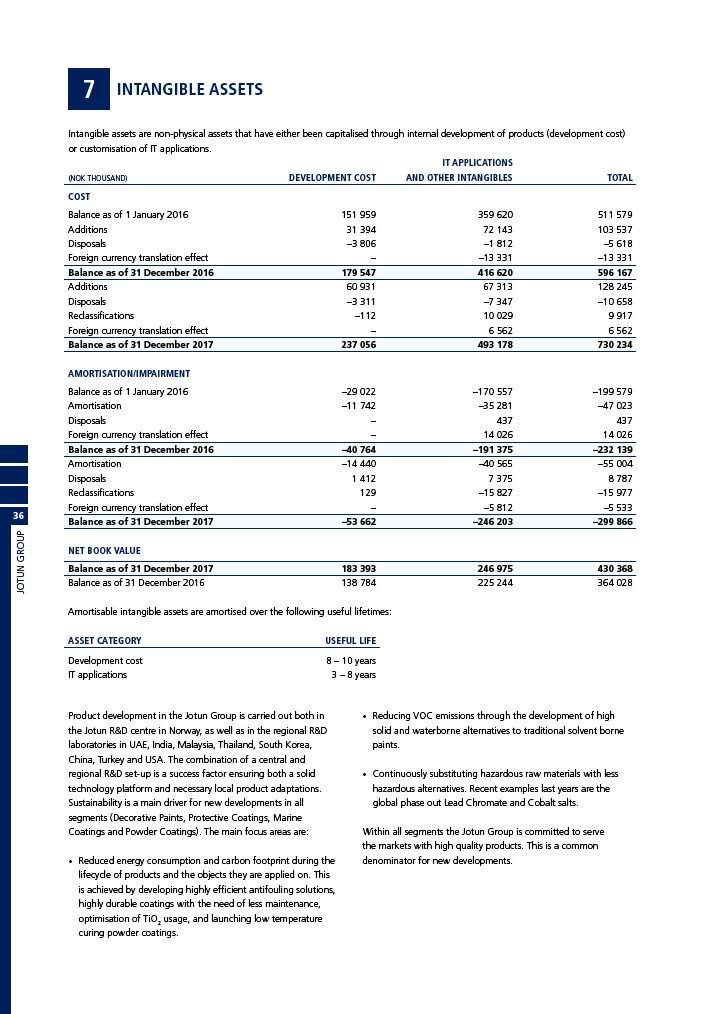
36
JOTUN GROUP
7 INTANGIBLE ASSETS
Intangible assets are non-physical assets that have either been capitalised through internal development of products (development cost)
or customisation of IT applications.
IT APPLICATIONS
(NOK THOUSAND) DEVELOPMENT COST AND OTHER INTANGIBLES TOTAL
COST
Balance as of 1 January 2016 151 959 359 620 511 579
Additions 31 394 72 143 103 537
Disposals –3 806 –1 812 –5 618
Foreign currency translation effect – –13 331 –13 331
Balance as of 31 December 2016 179 547 416 620 596 167
Additions 60 931 67 313 128 245
Disposals –3 311 –7 347 –10 658
Reclassifications –112 10 029 9 917
Foreign currency translation effect – 6 562 6 562
Balance as of 31 December 2017 237 056 493 178 730 234
AMORTISATION/IMPAIRMENT
Balance as of 1 January 2016 –29 022 –170 557 –199 579
Amortisation –11 742 –35 281 –47 023
Disposals – 437 437
Foreign currency translation effect – 14 026 14 026
Balance as of 31 December 2016 –40 764 –191 375 –232 139
Amortisation –14 440 –40 565 –55 004
Disposals 1 412 7 375 8 787
Reclassifications 129 –15 827 –15 977
Foreign currency translation effect – –5 812 –5 533
Balance as of 31 December 2017 –53 662 –246 203 –299 866
NET BOOK VALUE
Balance as of 31 December 2017 183 393 246 975 430 368
Balance as of 31 December 2016 138 784 225 244 364 028
Amortisable intangible assets are amortised over the following useful lifetimes:
ASSET CATEGORY USEFUL LIFE
Development cost 8 – 10 years
IT applications 3 – 8 years
Product development in the Jotun Group is carried out both in
the Jotun R&D centre in Norway, as well as in the regional R&D
laboratories in UAE, India, Malaysia, Thailand, South Korea,
China, Turkey and USA. The combination of a central and
regional R&D set-up is a success factor ensuring both a solid
technology platform and necessary local product adaptations.
Sustainability is a main driver for new developments in all
segments (Decorative Paints, Protective Coatings, Marine
Coatings and Powder Coatings). The main focus areas are:
• Reduced energy consumption and carbon footprint during the
lifecycle of products and the objects they are applied on. This
is achieved by developing highly efficient antifouling solutions,
highly durable coatings with the need of less maintenance,
optimisation of TiO2 usage, and launching low temperature
curing powder coatings.
• Reducing VOC emissions through the development of high
solid and waterborne alternatives to traditional solvent borne
paints.
• Continuously substituting hazardous raw materials with less
hazardous alternatives. Recent examples last years are the
global phase out Lead Chromate and Cobalt salts.
Within all segments the Jotun Group is committed to serve
the markets with high quality products. This is a common
denominator for new developments.